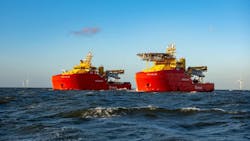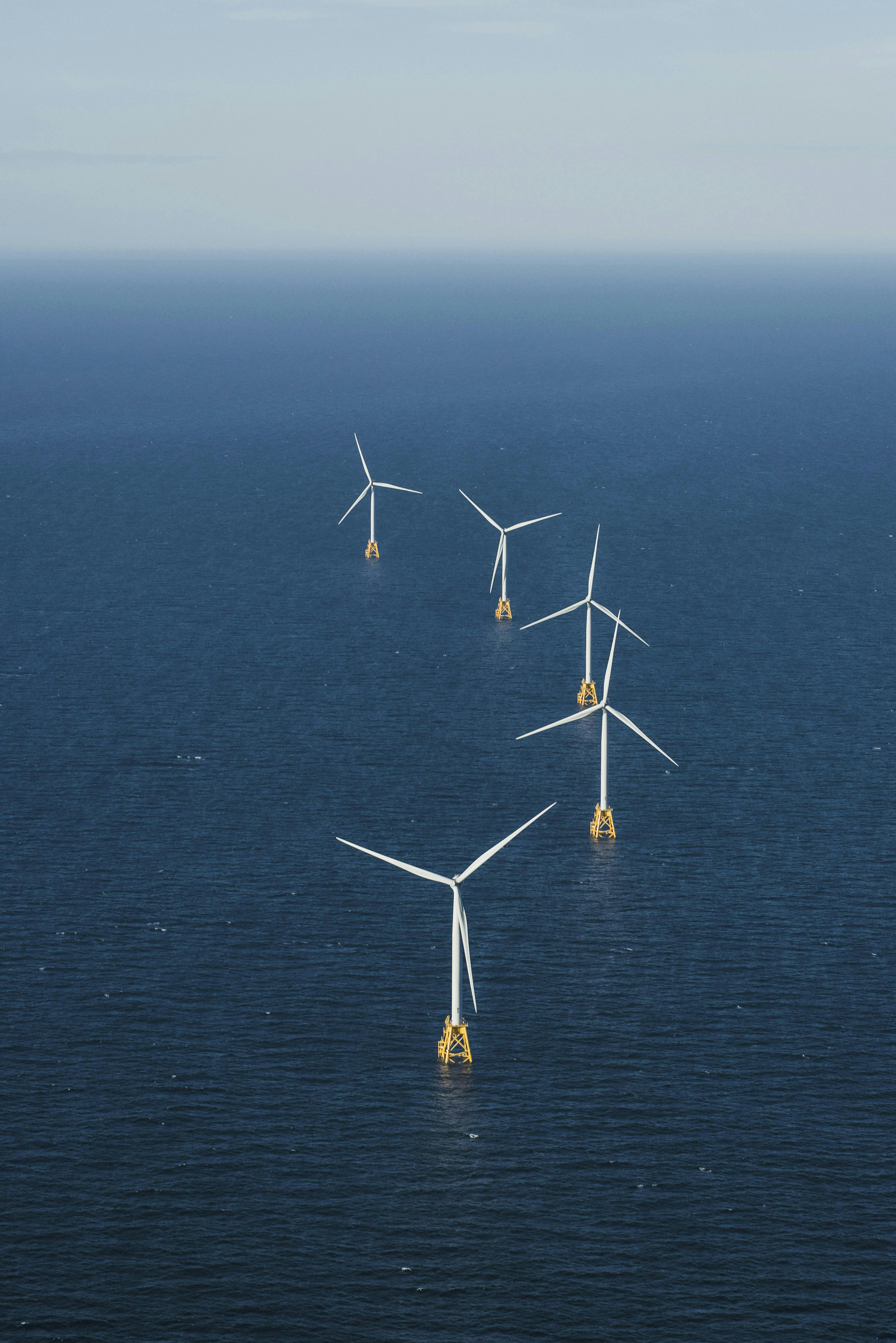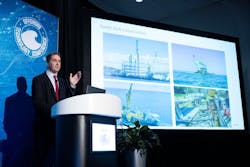Editor's note: This feature first appeared within the 2024 Offshore Wind Special Report and published within the July/August issue of Offshore magazine.
By Ariana Hurtado, Editor and Director of Special Reports
Ørsted is no newcomer to the offshore wind sector. The company claims it has built more offshore wind farms than any other developer in the world. With projects located offshore Denmark, Germany, the Netherlands, Poland, Taiwan, the UK and the US, the Denmark-based developer has installed 8.9 GW of offshore wind and says it has another 10.3 GW either under construction or awarded.
Ørsted’s offshore wind projects in the US include Block Island Wind Farm, Coastal Virginia Offshore Wind (CVOW), Revolution Wind, South Fork Wind and Sunrise Wind.
Offshore Rhode Island, the company purchased Block Island—America’s first offshore wind farm, which has a 30-MW capacity, five turbines and has been in commercial operation since 2016.
Ørsted completed work in 2020 on the CVOW project for Dominion Energy by supporting the engineering, procurement and construction work. Located offshore Virginia Beach, CVOW has a 12-MW capacity and two turbines. Dominion received the last two major federal approvals needed to begin construction of its 2.6-GW CVOW project in January of this year. It is on schedule to be fully constructed in late 2026.
Offshore Rhode Island and Connecticut, Global Infrastructure Partners (50%) and Ørsted's (50%) Revolution Wind project is expected to reach completion in 2025. The project will provide 304 MW to Connecticut and 400 MW to Rhode Island. Ørsted made its final investment decision on the 704-MW project in November 2023. The following month construction of the $1.5 billion offshore wind farm was approved.
Ørsted’s South Fork, which is 35 miles east of Montauk Point, New York, installed the first of its 12 turbines in November 2023 and delivered first power to the state’s power grid in December. In June of this year, the US Bureau of Safety and Environmental Enforcement (BSEE) conducted an inspection at the South Fork project, the bureau’s first inspection of an operational offshore wind turbine in US waters. BSEE said its inspection team evaluated South Fork’s risk analysis, procedures, and controls from the onshore control and coordination center. They also went offshore to observe control, coordination, pre-job planning, crew transfer and drill performance as well as to conduct a visual inspection of the turbine.
In March of this year, the 924-MW Sunrise Wind development serving New York received its record of decision from the US Department of the Interior's Bureau of Ocean Energy Management (BOEM). At the same time, Ørsted made a final investment decision on Sunrise Wind and began onshore construction activities. In June, Sunrise Wind received approval of its construction and operations plan from BOEM, which is the final permit needed from the federal agency to move the project toward the start of offshore construction. The project is scheduled to be operational in 2026. The project is located more than 30 miles east of Long Island’s Montauk Point.
Earlier this year, Eversource sold its 50% stake in South Fork and 50% holdings in Revolution Wind to Global Infrastructure Partners and its 50% ownership in Sunrise Wind to Ørsted.
At this year’s Offshore Technology Conference in Houston, Ørsted Americas's Troy Patton, head of program execution, led an offshore wind keynote session and addressed plans for the company's US wind projects, how technology is advancing and how lessons can be learned from other global wind farms.
He also stated that Ørsted has invested more than $2 billion in the US supply chain so far. “If you want to develop an offshore wind farm anywhere in the world, you need the rights of the seabed, you need construction permits, you need a place to interconnect and you need an offtake, some sort of power purchase agreement or somebody's agreed to buy those megawatt hours for two or three decades,” Patton explained.
During the May event, he said that South Fork was just completed, Revolution was currently going into the water, and Sunrise would follow soon. Other projects he noted were Vineyard Wind, a joint project going in off the coast of Massachusetts; Empire Wind, an Equinor project going in off New York; and CVOW, a Dominion project going in off Virginia. “All of these will be under construction in the next three years,” he added. “So there’s an awful lot of activity going on.”
Technology advancements
Patton said there have been lessons learned that can be shared from other parts of the world and applied to US offshore wind projects. He explained how technology has been developed and “perfected” for decades for offshore wind projects in the North Sea, offshore Denmark, Germany and the UK. The companies in these regions “figured out how to do it even faster and how to do it more economical,” he added. “They got really efficient at the technology and building over and over again.”
Ørsted’s Hornsea wind farm development in the UK southern North Sea taught his team “the importance of figuring out what you're doing, stabilizing around known technologies and doing the same thing over and over again as a way to get fast, efficient and inexpensive [results],” he said. “So that's one of the lessons we brought to what we call the Northeast [US] programs, which is South Fork, Revolution and Sunrise,” for which he said they are starting with 12 turbines but plan to have 150 turbines in the water in the next two years.
“Offshore winds continue to evolve as the tech has gotten bigger,” Patton continued. “We're pushing 2,500-metric ton foundations into the water now, which has never really been done. We're pushing crane sizes on heavy-lift vessels, which have never really been used outside the big offshore substations as they go in.”
Patton believes a technology needs to reach a technology readiness level of six or seven before installing it in the water and expecting it to last for up to three decades or so. “When it comes to structural elements, that's probably where we're the most conservative and wanting to make sure that that these turbines can be installed and safely operated for decades," he said.
Turbine technologies continue to leap forward both onshore and offshore, he added. However, “the three big OEMs—GE, Vestas and Siemens—have really struggled in the last few years economically,” Patton said. “GE and Siemens both spun out their power divisions, and they lost a lot of money before doing that. So, if nothing else, pure economics is going to dictate the multibillion-dollar development program for the next generation of turbines; there's not enough money to do that right now. And probably the market can't move fast enough to make that make sense. So, there's been what I consider a much-needed pause in that to allow vessel technology to catch up, the installation technology to catch up, allow us to rinse and repeat a few more times before tech has taken the next leap. It will happen, but I think it'll still be a few years before we get to the next generation in terms of size. In the meantime, we can catch up with everything else.”
He continued, “As a former turbine OEM guy myself, I do feel like you need to produce 1,000 of something at the scale before you really figure it out. And we haven't really given offshore the chance to do that in the speed that the Brits especially were moving in the last decade or so. So, I think we're entering a safer period now for the industry. It's safer economically [and] fiscally for the manufacturers and suppliers; it will give us a chance in the United States to allow the supply chain to catch up.”
US waters not all the same
Patton emphasized the importance of developing partnerships with local service businesses. He said there are about 25 vessels working on a project at any given point installing foundations in the water and then installing the turbines, connecting array cables, and scour protection and boulders are going in at the same time. In addition, US Coast Guard vessels are patrolling to make sure fishing boats and commercial shipping traffic stays out of the way.
Ørsted is coordinating with companies familiar with working in the Gulf of Mexico to help with service and installations on the Northeast US coast. However, water conditions are not the same in these two regions, and there is a learning curve, he said. The Gulf of Mexico vessels are used to operating in very deep water, but in the Northeast region waters are typically 100 ft to 150 ft.
“The long wavelengths coming off the coast of Africa and Europe making it here put conditions off the Northeast coast of the US for us, over this winter, like nothing that I think has been seen in the Gulf, and certainly nobody in the very small North Sea had ever encountered before,” he continued. “So we're learning. We're glad we only had 12 [turbines] to start with. We're taking some of those lessons, along with a lot of vessel operators from oil and gas that also serve offshore wind, to the installations that we're starting right now.”
Global offshore wind projects
For Germany, Ørsted is building what it says will be the country’s largest offshore wind farm, Borkum Riffgrund 3, in the North Sea. This project entails 83 Siemens Gamesa 11-MW turbines, 200-m rotor diameter and 913-MW total capacity. The company submitted the first zero-subsidy bid in an offshore wind auction by concluding long-term power purchase agreements with Covestro, Amazon, REWE Group, BASF and Google for a total of 686 MW. The Seaway Ventus vessel installed the first wind turbine on Borkum Riffgrund 3 in June.
For floating offshore wind farm projects, Ørsted has two projects currently in development offshore Scotland: Salamander (with partners Simply Blue Energy and Subsea7) and Stromar (with partners Renantis and BlueFloat Energy). Both projects are scheduled to enter commercial operation before and/or during 2030.
The Salamander joint venture submitted an offshore consent application in May of this year. The proposed 100-MW floating offshore wind farm would be constructed 35 km from the coast of Peterhead, eastern Scotland, in the UK central North Sea.
In March of this year, Sulmara won a contract to perform site characterization at the Stromar floating offshore wind farm near northern Scotland. The company will use the multipurpose subsea vessel Vos Gorgeous for the geophysical investigations across the site in water depths of up to 100 m.
About the Author
Ariana Hurtado
Editor-in-Chief
With more than a decade of copy editing, project management and journalism experience, Ariana Hurtado is a seasoned managing editor born and raised in the energy capital of the world—Houston, Texas. She currently serves as editor-in-chief of Offshore, overseeing the editorial team, its content and the brand's growth from a digital perspective.
Utilizing her editorial expertise, she manages digital media for the Offshore team. She also helps create and oversee new special industry reports and revolutionizes existing supplements, while also contributing content to Offshore's magazine, newsletters and website as a copy editor and writer.
Prior to her current role, she served as Offshore's editor and director of special reports from April 2022 to December 2024. Before joining Offshore, she served as senior managing editor of publications with Hart Energy. Prior to her nearly nine years with Hart, she worked on the copy desk as a news editor at the Houston Chronicle.
She graduated magna cum laude with a bachelor's degree in journalism from the University of Houston.



